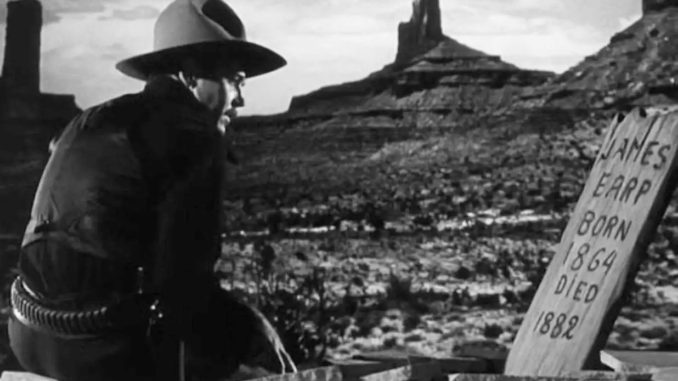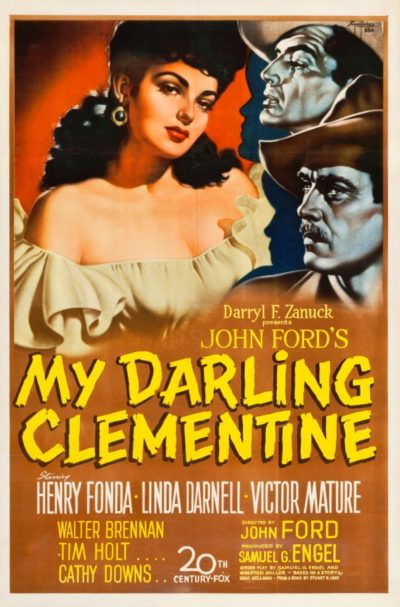
Rating: B
Dir: John Ford
Star: Henry Fonda, Victor Mature, Cathy Downs, Walter Brennan
We came to this in a weird way, after it was featured in an episode of the show M*A*S*H*. The film was shown to the 4077th, and described as Colonel Potter’s favourite Western. Between that and the Arizona connections, it was an easy choice, and is certainly one which has stood the test of time well. Despite the title, it’s not particularly romantic: it’s more Gunfight at the OK Corral with a love interest on the side. Mind you, it also has Doc Holliday declaiming Shakespeare, so historical accuracy may not be its strongest suit. Nor geographical accuracy, with Tombstone re-located five hundred miles north, to the iconic landscapes of Monument Valley, on the Arizona/Utah border.
The Earp boys are driving cattle through the region, when one of their number is killed by rustlers. Wyatt Earp (Fonda) decides to stick around in the area and find the culprits, becoming the town’s marshal. There, he crosses path with Holliday (Mature), who effectively runs Tombstone, and also the Clanton gang, under their patriarch (Brennan). Doc’s ex-girlfriend, Clementine Carter (Downs), comes out from Boston to find him, but he wants nothing to do with her, since he’s dying of TB. [So… much… coughing…] His present dame, Chihuahua – presumably so-called because she’s small and yappy – is none too pleased by the new arrival. Wyatt is even less happy to discover his late brother’s silver cross in Chihuahua’s possession, kicking off events which lead to the Wild West’s most famous shoot-out.
 Again, despite the poster, it’s worth stressing that Clementine is definitely a supporting character. She’s a factor in the main dynamic, which is the relationship between Doc and Wyatt. They are a pair of alpha males who initially perceive each other as a threat, only to discover eventually there’s a common threat in the Clantons, and they need to work side-by-side to take it out. Clementine and Chihuahua (Linda Darnell – not exactly the most Hispanic of performances, shall we say!) are more distractions to that goal. There were certainly times where Wyatt appeared to have forgotten the reason he was supposed to be in town, with the investigation of his brother’s murder taking a back seat to playing poker, hanging out with itinerant Shakespearean actors, etc.
Again, despite the poster, it’s worth stressing that Clementine is definitely a supporting character. She’s a factor in the main dynamic, which is the relationship between Doc and Wyatt. They are a pair of alpha males who initially perceive each other as a threat, only to discover eventually there’s a common threat in the Clantons, and they need to work side-by-side to take it out. Clementine and Chihuahua (Linda Darnell – not exactly the most Hispanic of performances, shall we say!) are more distractions to that goal. There were certainly times where Wyatt appeared to have forgotten the reason he was supposed to be in town, with the investigation of his brother’s murder taking a back seat to playing poker, hanging out with itinerant Shakespearean actors, etc.
Even so, it’s never less than interesting to watch. Ford’s eye for framing both the people and its landscapes is excellent, although each feel occasionally too large for the narrow 4:3 aspect ratio in which it was shot. Mature is particularly good, commanding the screen with his presence, and his Holliday is a surprisingly dark character, from an era when Westerns very much tended to be white hat vs. black hat. On first meeting Holliday, Earp says, “A man could almost follow your trail, goin’ from graveyard to graveyard,” establishing both men’s moral positions. That they end up on the same side, facing the greater evil of the Clantons, is the real story here, and not a song about a gold prospector.
